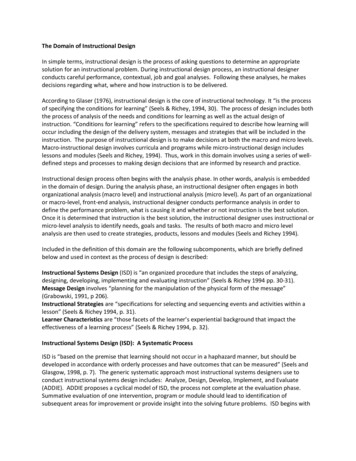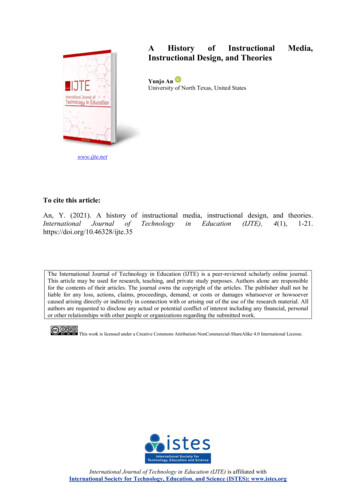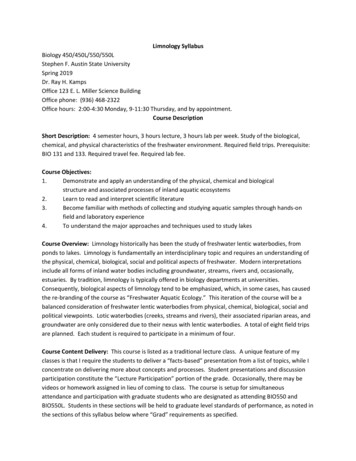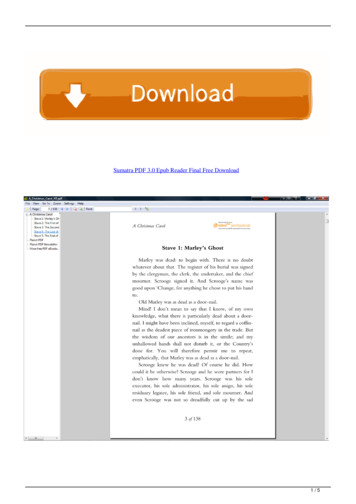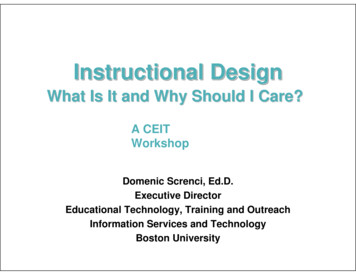
Transcription
Instructional DesignWhat Is It and Why Should I Care?A CEITWorkshopDomenic Screnci, Ed.D.Executive DirectorEducational Technology, Training and OutreachInformation Services and TechnologyBoston University
Instructional Design: What Is Itand Why Should I Care?You’ve heard of “Graphic Design,” “Information Design,”Fashion Design, and even “Industrial Design” — but maybenot “Instructional Design.”Presentation Goals: To cover the historical context and help to define thediscipline of Instructional Design. To explore how a systems approach todevelopinginstruction will serve your teachingneeds.
ID Workshop Opening Exercise Participants will be working individually or insmall groups. Assume the role of product designer Identify the steps that will need to be taken tobuild and deliver that product to market. Pick a product:Toaster, Can Opener, Microwave,Clock Radio, Camera, Pencil Sharpener Together we will record the stepseach group has identified.
Instructional Design“A Systematic Approach to Instruction”Is the “systematic and reflective processof translating principles of learning andinstruction into plans for instructionalmaterials, activities, informationresources, and evaluation”.(Smith 1999)
How would you build a car?RevisionMarketResearchAnalysisDesignProduction Prototyping DeliveryCustomerFeedbackPerformanceand RepairStats
How would you build a ion Prototyping DeliveryCustomerFeedbackPerformanceand RepairStatsInstructional Design ProcessRevisionNeedsAssessment teDick and Carey Model 1978
Instructional Design Milestones 1920’s– Started to match the needs of society toeducation and connecting outcomes andinstruction.
Instructional Design Milestones 1930’s– The 8 year study plan by Ralph Tyler was a majormilestone in specifying general objectives foreducation.– The study was designed in response to postwarpressures to revise the prevailing college prep highschool curriculum in order to meet the needs ofincreasing numbers of students.– The study confirmed that objectives could be clarifiedif written in terms of student behaviors.– Formative evaluation was used for the first timeduring the study.
What Lead to the Development ofInstructional Design? 1940’s– World War II created an enormousinstructional problem - thousands of newrecruits had to be trained rapidly, and thesophistication of new weapons demanded anunprecedented level of mastery.– Mediated strategies such as the use of filmsfor instruction and AV technology weredominant.
ADDIE Instructional Design Cycle
Instructional Design ModelInstructional Systems Design is an organized procedure thatincludes steps of analyzing designing, developing, implementing andevaluating instruction.ADDIE: (wikipedia.org/wiki/ADDIE Model#Analysis Phase)Analyzing – Assessing the learning and defining what is to be learnedDesigning – the process of specifying how it is to be learnedDeveloping – the process of authoring and producing theinstructional materialsImplementation – is actually using the materials and strategies incontextEvaluating – is the process of determining the adequacy of theinstruction
Instructional Design Model Characteristic of the Instructional Designprocess is that all the steps must be completedin order to serve as a check and balance oneach other. 90-100 ID Models in existance The Process is as important as the Product Confidence in the Product is based on theProcessThe Process is the Product
Boston UniversityCenter for Educational Development in HealthDesign for Learning Systematic Approach for tterExpertInstructorSomething is missing!Post-graduate
Boston UniversityCenter for Educational Development in HealthDesign for Learning Systematic Approach for CourseDevelopmentCompetency-basedInstructional orThe missing link!
Systematic Approach to DesignInstructional Design ProcessRevisionNeedsAssessment AnalysisDesignBoston UniversityCenter for Educational Development in HealthProductionPilotTestingDeliveryEvaluate
Center for Educational Development in HealthModel for Systematic Course DesignForm 1InstructionalSituationForm 4Form 3Form 5Form 6Form 7Form SessionPlans
Instructional SituationsCourse Title:Course Goal:Expected Students:Number of StudentsEducational BackgroundSetting:Constraints:Such as.1.No time to prepare2.Large number of studentsResources:Such as.1.Funds2.Personnel3.Laboratory facilities4.Etc.
Performance ExpectationsJob TitleTasksProcedureFindingsForm 2a: Verify Performance Expectations: Literature Search andInterview
Competence Based ObjectivesForm 3a Competency Based Learning, Objectives (First Part)Objective:When given The student will be able to .Objective:When given The student will be able to .Objective:When given The student will be able to .
Relationship of Objectives andEvaluationObjectives
Relationship of Objectives andEvaluationObjectivesEvaluation
Learning ObjectivesRobert F. Mager 1969Mager, R.F. (1984). Preparing instructionalobjectives. (2nd ed.). An objective is a description of a performanceyou want learners to be able to exhibit before youconsider them competent. An objective describes an intended result ofinstruction.
Learning Objective Parts Behavior Condition Standard
Learning Objective Parts Behavior– The behavior element of a learning objective (LO)describes what the student is expected to do aftertraining. Condition– The condition refers to the circumstances underwhich the behavior will be performed Standard– The standard element of a learning objectiveindicates how well the student is expected to performthe behavior - quantity and/or quality of theperformance.
ObjectivesSkills, Knowledge and Attitude
Objective Action VerbsInformationComprehension elistname
Objective Action etranslateupdatevalidate
Verbs That Impart “Skills” hold manageprojectwritediagraminternalizemeasurerecord
Verbs that Convey “Attitudes” acquireexemplifyplanreflecttransfer considermodifyrealizerevise
Instructional Activities
Evaluation in InstructionalDesign Evaluation is the systematic determinationof learning outcomes.– Formative– Summative It is a process by using measures againsta set of objectives. Program Evaluation
Formative Evaluation Permit the instructional designers, instructorsand learners to monitor how well theinstructional goals and objectives are being met. Its main purpose is to catch deficiencies so thatthe proper learning interventions can take placethat allows the learners to master the requiredskills and knowledge
Summative Evaluation Is a method of judging the success of ainstructional intervention that focuses is onlearning outcome. Various instruments are used to collect thedata.– Questionnaires, surveys, interviews,observations, and testing.– Should be designed to meet learningobjectives
Evaluation PlanTesting ConditionsWhen given.ENTRY TESTPROGRESS TESTPROGRESS TESTPROGRESS TESTPROGRESS TESTPOST TESTPerformanceThe student will be able to
Evaluation InfluencingActivitiesEvaluation(From EvaluationPlan)Activities
The Syllabus –Organized ActivitiesSession #In-Class Outside ActivitiesActivities IntroLectureRole PlayDiscussionWeek 2 LectureVideoLabTest ReviewWeek 3 Interview PanelDiscussion Team BasedExerciseWeek 1 Reading Field TripExercise Journal Lab Reports Blog PostFlipping the Classroom
Design Stage Design– Don’t Reinvent the Wheel– Evidence-Based Methods– Innovation– Instructional Methods– Cognitive Load– Solution-Based Approach– Creativity
Production Stage Production– Limitations– Media– Visual– Time, Quality and Cost
Teaching as Research Instructional Design Systematic Instructional Design Establishing a framework for the research
Instructional DesignResources
American Society forTraining and Developmenthttp://www.astd.org/About
Instructional Design Model Characteristic of the Instructional Design process is that all the steps must be completed in order to serve as a check and balance on each other. 90-100 ID Models in existance The Process is as important as the Product Confidence in the Product is based on the Process The Process is the Product





